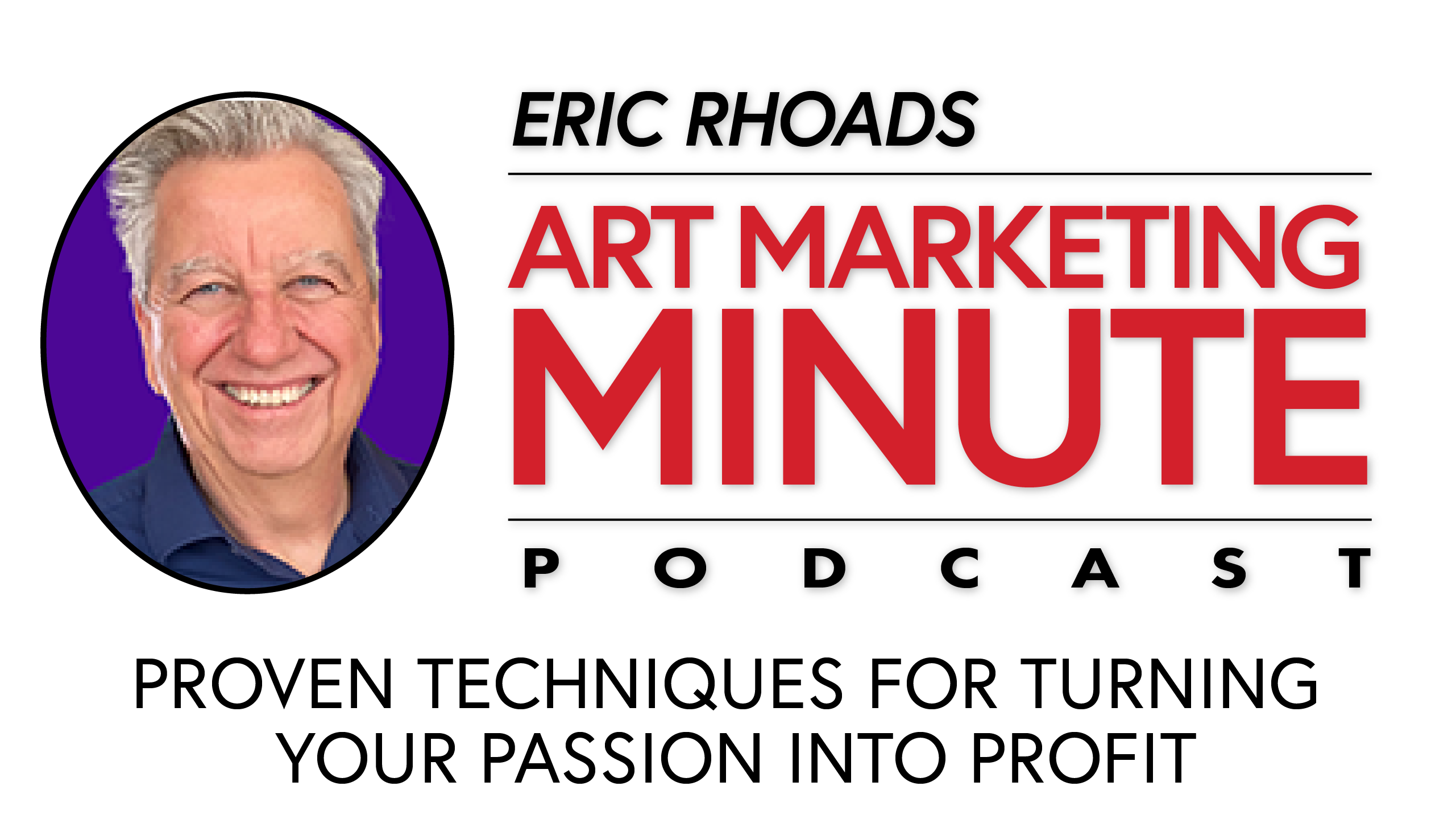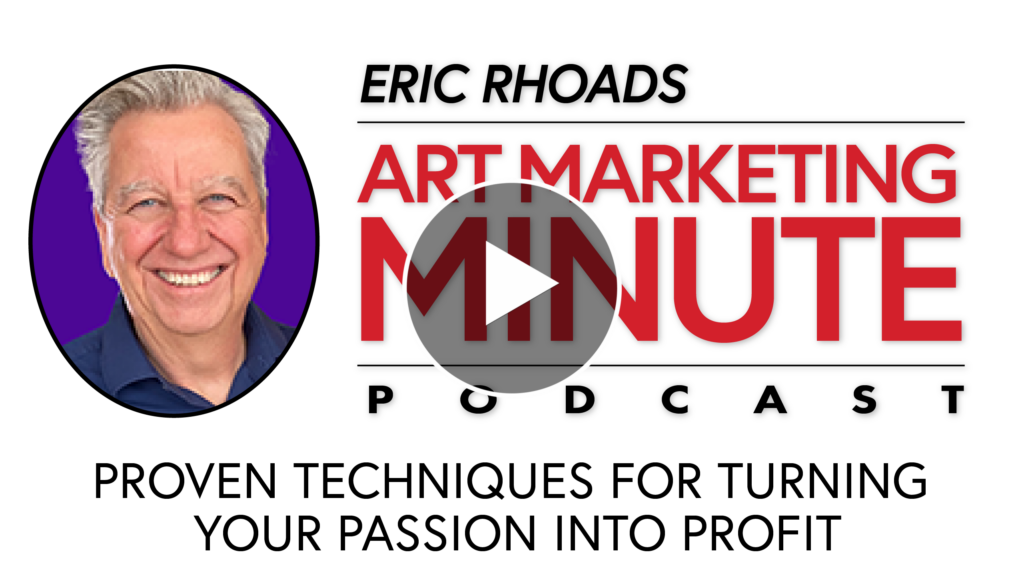What are some ways for artists to effectively use social media? How do you get more eyeballs on your Instagram posts that will lead to serious potential buyers? Eric Rhoads answers in this week’s Art Marketing Minute Podcast.
Get your copy of Eric’s #1 Amazon Best Seller, “Make More Money Selling Your Art: Proven Techniques for Turning Your Passion Into Profit” here.
Listen to the Art Marketing Minute Podcast: Episode 140 >
Submit Your Art Marketing Question:
What questions do you have about selling your art? E-mail Eric at [email protected] (include your name and where you’re from) to hear your question answered on an upcoming Art Marketing Minute Podcast.
FULL TRANSCRIPT of the Art Marketing Minute:
DISCLAIMER: The following is the output of a transcription from an audio recording of the Art Marketing Minute. Although the transcription is mostly correct, it is sometimes slightly inaccurate due to the recording and/or software transcription.
Announcer:
This is the Art Marketing Minute with Eric Rhoads, author of the Amazon best-selling book, “Make More Money Selling Your Art.” In the marketing minute, we answer your questions to help your art career brought to you by ArtMarketing.com, the place to go to learn more about marketing. Now, here’s your host, art magazine publisher, Eric Rhoads.
Eric Rhoads:
So if you have questions, you can email them [email protected] By the way, artmarketing.com is a really great resource. There’s a lot of articles on there about marketing your art, and a good place to kind of poke around. And so check it out. If you guys ever want to come live on the podcast to record your questions. I do a lot of live on the weekday, Monday Marketing Show for art school live on YouTube. Here’s a question from Linda Jack from Virginia. I’m seeing these for the first time. By the way, the question is pricing and how to use social media effectively are always a struggle. Any suggestions? Well, those are two big questions, two questions that deserve a lot of time on their own. Pricing is the most difficult thing, other than learning to paint, that I think artists have to deal with and pricing has a lot to do with the environment that the painting is sold in. Keep that in mind that now if you were selling paintings at a high end show filled with multi millionaires, and they were selling $20 paintings there people aren’t going to buy them, because they’re not going to think they’re any good. And but if you’re selling paintings at the farmers market or the flea market or something, that’s going to be a different story too. So environment, the type of gallery you’re in, if you’re in a gallery, the environment makes a big difference. And so always think in terms of environment. Now you should, typically not, I don’t like to have rules, but I like to have guidelines. You typically should have your prices be your prices so that somebody, especially if you’re a gallery artist, if your paintings are in a gallery in Wisconsin and they’re in a gallery in California, and you can look them all up online. You want to have, you know, similar pricing, so that a nine by 12 is the same as a nine by 12. Now there are exceptions to that, because sometimes I’ll work on a painting for 100 hours, and I want to get more money for it. And so that would be an exception, because not not all paintings are equal, even if they’re equal in size. And then there’s all kinds of great books on pricing, but pricing is about kind of testing the market, putting it out there, starting a little higher if it sells well, move it up a little higher. More. If it sells well, move it up a little higher, more. If it doesn’t sell well, move it down a little bit. And also build in a little room for negotiation, because sometimes people need to negotiate. Some people can afford it, but they don’t. They won’t buy unless they can get a better deal. So just build in a little of that into your pricing, in terms of social media, in terms of effectively doing social media. You know, there’s, there’s courses on this. It’s not an easy task to just give you an answer to this, but I will tell you this, there’s a couple of things about social media. First off, what I’m learning is that post it depends on on what you’re posting on, so if you’re posting on X, formerly Twitter, then you can post 3, 4, 5, 6, times a day, because it moves very fast. If you’re focusing on Instagram, experts say once, maybe twice a day. If you’re focusing on Facebook, three, four times a day is fine, but it depends, because there are what we call time zones, or the times when people tend to check, you know, the masses. There are times when the masses are there. And the masses are typically there before work, during lunch time and after work. And so the busiest time for social media typically is after work. Now, different time zones are going to see things different ways. And so, you know, it’s, it’s nine o’clock in New York, it’s six o’clock in in Laguna. So you know you want to kind of time things to the time when the audience that you’re trying to reach is most important. And then keep your content focused on what you want your content to be known for. So if you, for instance, are a painter, and you want to be known as a painter for collectors or finished paintings, then you know, only put finished paintings on there, or maybe, maybe you painting in a location with that painting in the finished painting. I don’t like progress shots, typically, because most people don’t read that it’s in progress, and they look at it and they go, Ah, it’s not done. Or they’ll look at it and go, Oh, it’s it’s not good. So be careful about sharing progress shots. If you have a social media account that your primary purpose is to sell paintings, then don’t show pictures of food. Your cat. Keep it all about paintings, and then, you know, you can talk about the stories of the paintings. You can ask people for for comments. You can even say, you know, this one’s available. Sometimes I wouldn’t put that in the main post, but I put it in the first comment. So by the way, this is available, right? That way you’re not being too salesy, but that’s just a matter of opinion. So there’s a ton of other things social media is ever changing. It’s got to study it all the time. The you know, hashtags were all the rage now they’re not. They don’t matter anymore, because AI is kind of picking up and running with things, and so that that changes a lot.
Second question comes from Pat watam in Louisiana. Pat says, How do you get more eyeballs on your Instagram posts that will lead to serious potential buyers? Well, you know, it’s really the same question. The way to get eyeballs is to get people to to you gotta post. Post frequently. You gotta just because you post something doesn’t mean you can’t repost it. You know, I post things sometimes the same thing, 3456, times a year, at different times, because I want to be talking about things that are going on, or things that I’m doing, or things that are paintings that I’ve done, and you know you, you don’t always know who’s going to see them. So the algorithm at Facebook, and this is constantly changing, but Facebook, typically, if you have, let’s say you have 5000 followers of Facebook, is only going to show that to 200 maybe 100 followers. One, two, 3% maybe not even that. And if there’s a lot of interaction, if people make comments, if people if you’re responding to comments, if people are engaged, or if people share it a lot, then they will show it to a couple, a couple 100 more people, and then if that continues, they’ll show it to more and more. So the idea is you want to look for ways to get engagement, which is why asking questions. Do not be so bold as to say, Hey, give me a like or something like that, because that’s considered click bait. But you can just, you know, you can ask a question, you know, what does this painting remind you of? And that way you get engagement? Or does anybody know where this painting was done, or something like that? So you just get people talking and then make sure you respond. That’s one of the best ways to get eyeballs. Because I even learned recently that even if you have a Facebook group like I have Facebook groups. I have dozens of them for some of the various things that we do, like our we have a private Facebook group for fall color week, which is coming up, and as a result, only those people can see it. But Facebook doesn’t even push it out to all of them. I thought they did. They only push it out to five or 6% of those. And again, if there’s engagement, they’ll push it out to more. So you’re not even guaranteed that, if you’re in a group, that everybody’s going to see everything. So keep that in mind. Okay, well, anyway, that’s the art marketing minute. I do art marketing Mondays on my show art school live. You can find that on YouTube, and we do a whole lot more there. So anyway, there we go. Art marketing minute.
How to Submit Your Art Marketing Questions: What questions do you have about selling your art? Submit it at artmarketing.com/questions to hear your question answered on an upcoming Art Marketing Minute Podcast.
The Art Marketing Minute Podcast has been named one of the 2023 “Top 25 Art Business and Marketing Blogs on the web” by FeedSpot.



Leave A Comment